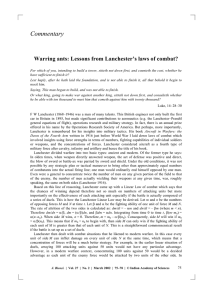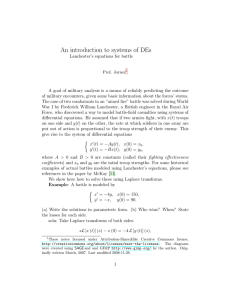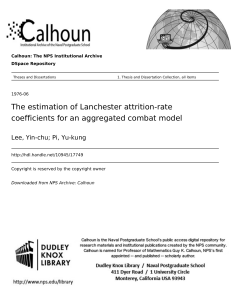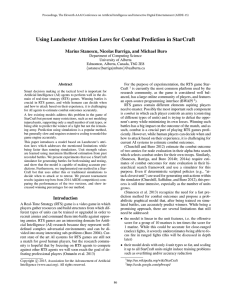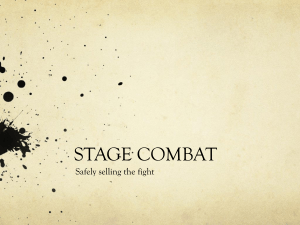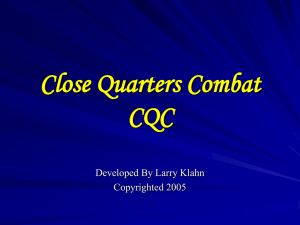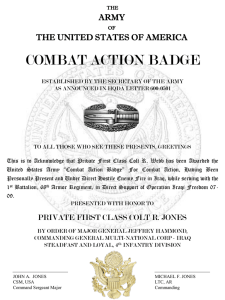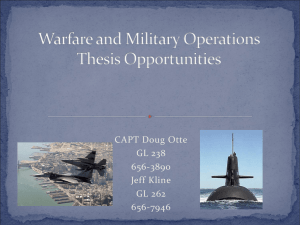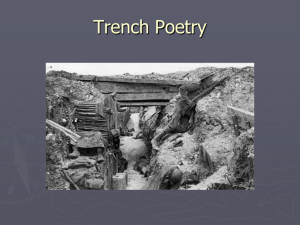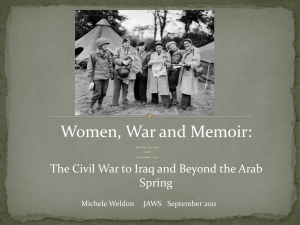File
advertisement
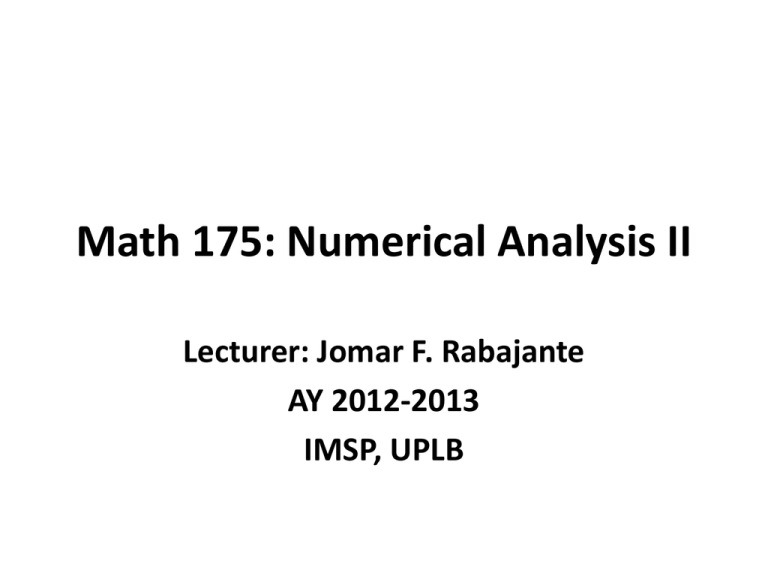
Math 175: Numerical Analysis II Lecturer: Jomar F. Rabajante AY 2012-2013 IMSP, UPLB Simple Romeo and Juliet Conflict Model dR aJ dt dJ bR dt a, b 0 Two Famous Classes of Conflict Models • Lanchester models (combat or attrition models) • Richardson models (arms race models) LANCHESTER MODELS • Here, x force and y force are engaged in battle. • The nonnegative variables x(t) and y(t) denote the strength of the forces at time t, where t is measured in days since the start of the conflict. • For ease, let the strength be the number of soldiers. (This is an approximation since the number of soldiers is a discrete integer) A TYPICAL LANCHESTER MODEL The rate at which soldiers are added or lost: dx ( OLR CLR ) RR dt OLR – operational loss rate (loss due to diseases, desertions and other noncombat mishaps) CLR – combat loss rate RR – reinforcement rate THREE VERY TRADITIONAL LANCHESTER MODELS 1. Conventional Combat (CONCOM) For example, a & d can be the average per soldier death or desertion rate due to noncombat mishaps dx ax by P ( t ) dt dy cx dy Q ( t ) dt OLR THREE VERY TRADITIONAL LANCHESTER MODELS 1. Conventional Combat (CONCOM) dx ax by P ( t ) dt dy dt cx dy Q ( t ) CLR; b & c are the combat effectiveness coefficient THREE VERY TRADITIONAL LANCHESTER MODELS The combat efficiency coefficient is difficult to measure. One approach is to set (let’s just discuss b) b ry p y ry is the firing rate (shots/combatant/day) of the y force py is the probability that a single shot kills an opponent THREE VERY TRADITIONAL LANCHESTER MODELS 2. Guerilla Combat (GUERCOM) dx ax gxy P ( t ) dt dy dt cyx dy Q ( t ) CLR THREE VERY TRADITIONAL LANCHESTER MODELS Examples of Guerilla tactics: ambushes, sabotage, raids, the element of surprise, and extraordinary mobility to harass a larger and lessmobile traditional army, or strike a vulnerable target, and withdraw almost immediately. Usually, Guerilla tactics are used by smallernumbered force to attack larger-numbered force. Unlike CONCOM (which is one-on-one), the guerilla model is used in area-fire situations (concentrated firepower). THREE VERY TRADITIONAL LANCHESTER MODELS Imagine that a force occupies some region R. The enemy fires into R. Under this circumstances, the loss rate for the force is proportional to their number in region R. So do not be concentrated in one area! THREE VERY TRADITIONAL LANCHESTER MODELS The combat efficiency coefficient is difficult to measure. One approach is to set (let’s just discuss g) g ry p y where p A ry Ax Ary is the area of effectiveness of a single y shot Ax is the area occupied by the guerillas THREE VERY TRADITIONAL LANCHESTER MODELS 3. Mixed Guerilla-Conventional Combat (VIETNAM) dx ax gxy P ( t ) dt dy dt cx dy Q ( t ) What do you think is the applicable Lanchester model for the simple Romeo and Juliet Conflict Model? dR aJ dt dJ bR dt a, b 0 dR aJ dt dJ bR dt a, b 0 It is a CONCOM model without OLR and no replacements. Actually, this model is called the SQUARE LAW!!! The attrition rate of each belligerent is proportional to the size of the adversary. Richardson’s Model • Read the pdf file arms race model uploaded in our yahoogroup. This might help you in your project. INTERACTING POPULATION MODELS You can model: • Neutralism • Amensalism • Commensalism • Competition • Mutualism • Predation • Parasitism, etc… Lotka-Volterra Predator-Prey Model • • • • This is the grandpa of all predator-prey models. This is a “bad” model but is very historical. Let N(t) be the number (or density) of prey Let P(t) be the number (or density) of predators Prey will grow exponentially in the absence of predator. The loss of prey and the growth of predators are proportional to N and P. In the absence of prey, predators die out. dN rN cNP dt dP dt bNP mP Epidemics and Rumor models • Will be discussed in the laboratory. Simple Models of Electrical Circuit • Read the pdf file RLC circuit uploaded in our yahoogroup. I will use these models in one of your laboratory classes. So study how the DEs are derived.
